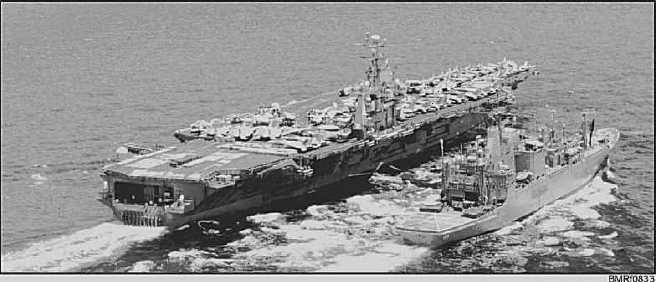permits a receiving ship to remain on station in combat
formation, eliminating the necessity of temporarily
immobilizing itself by going alongside another ship for
replenishment.
Ammunition Ships.—Ammunition ships (AEs)
(fig. 8-33) operate with replenishment groups to deliver
ammunition and missiles to the fleet at sea. Their design
incorporates a mechanical handling system for more
rapid loading and off-loading of ammunition. The
mechanical handling system includes such equipment
as dual-cantilevered elevators in the holds; forklift
trucks; and low-lift, power-operated transporters on the
main deck for handling palletized ammunition from the
elevators to the transfer stations. Universal portable
metal dunnage provides maximum stowage with ready
access to all types of ammunition. A tension highline
system is built into the design along with new, improved
electro-hydraulic cargo winches for replenishment at
sea. These improvements provide for much more rapid
and reliable transfers and conservation of deck space.
These ships are capable of handling all types of missiles
(fig. 8-34).
Oilers and Tankers.—Oilers (AOs), carrying
Navy fuel oil, jet fuel, and other petroleum products,
operate with replenishment groups and deliver their
cargo to ships at sea. Oilers, as well as ammunition ships
(fig. 8-35), can service ships on both sides simulta-
neously.
The AO (Jumbo) is a conversion of the AO that
includes the installation of a new midsection in the hull.
This midsection increases the payload and provides for
an improved balance of cargo fuel products to meet the
more recent demands placed upon the AO by the
increase in fleet requirements for jet aircraft fuel.
Fast Combat Support Ships.—The fast combat
support ship (AOE) is the largest and most powerful
auxiliary ship in the Navy. Unlike other replenishment
ships, the AOE is designed to operate as an integral
force rather than as a unit of an underway replenishment
group.
The AOE (fig. 8-36) is a multiple-product ship
(missiles, fuel, ammunition, and general cargo) that has
a cargo-fuel capacity greater than that of our largest
fleet oilers plus a hold capacity equal to the largest
ammunition ship. In addition, the ship carries a large
load of both general supplies, materials, and
refrigerated cargo.
Other than speed and capacity, this ship has two
major areas of improvement over other replenishment
vessels—material handling and replenishment at sea.
Materials, other than missiles and special weapons, are
moved vertically by elevators or conveyors. Horizontal
movement of general cargo and ammunition is
8-28
Student Notes:
Photograph courtesy of PH3 Jason Branson
Figure 8-33.—USS John C. Stennis (CVN 74) off-loads ammunition onto ammunition ship USS Mount Hood (AE 29).

